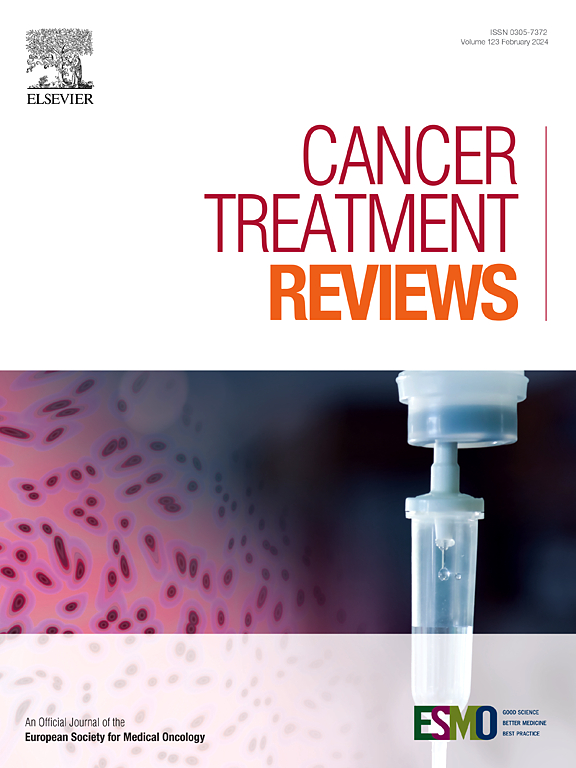T-cell engager toxicity in clinical phase trials; A systematic review and meta-analysis
IF 10.5
1区 医学
Q1 ONCOLOGY
引用次数: 0
Abstract
Engineered to activate a patient’s own immune response, T Cell Engagers (TCEs) are positioned to mediate T cell directed cytotoxicity through targeted engagement of a tumour antigen. Despite their attractive properties TCE therapies have yet to be widely used in the treatment of solid tumours with several obstacles that include adverse toxicity profiles.
This systematic review and meta-analysis assessed the toxicity associated with T-cell engagers (TCEs) in the treatment of solid tumours. Papers were sourced from MEDLINE, Cochrane Library, CINHL, EMBASE, Web of Knowledge, Scopus. Prevalence data from the identified primary studies was pooled using an inverse variance method with a restricted maximum likelihood estimator. Freeman-Tukey double arcsine transformation to determine toxicity prevalence and confidence intervals.
A total of 1147 publications were identified of which 30 were included for systematic review. Toxicity profiles from 17 TCEs, comprising 9 different ligands that utilised the CD3, CD40, CD28 or CD64 signalling pathways were characterised in this study. Of these studies, 21 publications were included for meta-analysis, focussing on four TCEs: catumaxomab, ertumaxomab, tebentafusb, and MDX-H210. Meta-analysis found that the most prevalent toxicities were gastrointestinal and inflammatory. Subgroup analysis revealed that Gastrointestinal toxicity (GI) toxicity was independent of tumour type or ligand. Cytokine Release Syndrome (CRS) is potentially being under-reported due to challenges of differentiation of CRS from other inflammatory mediated constituent symptoms, although Fc-independent TCEs were linked to lower inflammatory toxicity. The review highlights TCE-dependent toxicity profiles and highlights key features that may ameliorate TCE tolerance.

临床试验中的t细胞接合物毒性;系统回顾和荟萃分析
T细胞接合物(tce)被设计为激活患者自身的免疫反应,通过靶向接合肿瘤抗原介导T细胞定向的细胞毒性。尽管具有吸引人的特性,但TCE疗法尚未广泛应用于实体肿瘤的治疗,存在一些障碍,包括不良毒性特征。本系统综述和荟萃分析评估了与t细胞接合剂(TCEs)治疗实体肿瘤相关的毒性。论文来源于MEDLINE, Cochrane Library, CINHL, EMBASE, Web of Knowledge, Scopus。来自确定的主要研究的患病率数据使用限制最大似然估计的反方差方法进行汇总。Freeman-Tukey双反正弦变换确定毒性流行率和置信区间。共确定了1147份出版物,其中30份纳入系统评价。本研究表征了17种tce的毒性特征,包括9种不同的配体,利用CD3、CD40、CD28或CD64信号通路。在这些研究中,21篇出版物被纳入荟萃分析,重点是四种TCEs: catumaxomab、ertumaxomab、tebentafusb和MDX-H210。荟萃分析发现,最常见的毒性是胃肠道和炎症。亚组分析显示胃肠道毒性(GI)毒性与肿瘤类型或配体无关。细胞因子释放综合征(CRS)可能被低估,因为CRS与其他炎症介导的成分症状难以区分,尽管不依赖fc的tce与较低的炎症毒性有关。该综述强调了TCE依赖性毒性特征,并强调了可能改善TCE耐受性的关键特征。
本文章由计算机程序翻译,如有差异,请以英文原文为准。
求助全文
约1分钟内获得全文
求助全文
来源期刊

Cancer treatment reviews
医学-肿瘤学
CiteScore
21.40
自引率
0.80%
发文量
109
审稿时长
13 days
期刊介绍:
Cancer Treatment Reviews
Journal Overview:
International journal focused on developments in cancer treatment research
Publishes state-of-the-art, authoritative reviews to keep clinicians and researchers informed
Regular Sections in Each Issue:
Comments on Controversy
Tumor Reviews
Anti-tumor Treatments
New Drugs
Complications of Treatment
General and Supportive Care
Laboratory/Clinic Interface
Submission and Editorial System:
Online submission and editorial system for Cancer Treatment Reviews
 求助内容:
求助内容: 应助结果提醒方式:
应助结果提醒方式:


